南京大学:《计算机问题求解》课程教学资源(PPT课件讲稿)代数编码

计算机问题求解一论题4-5 代数编码 2017年04月10日
计算机问题求解 – 论题4-5 - 代数编码 2017年04月10日

间题1: 为什么易于发现错误, 甚至易于纠正错误的编 码方案非常重要? 首先当然是因为编码无处不在,不仅如此
首先当然是因为编码无处不在,不仅如此…
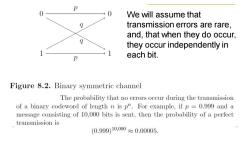
p 0 We will assume that q transmission errors are rare, and,that when they do occur, q they occur independently in 1 each bit. Figure 8.2.Binary symmetric channel The probability that no errors occur during the transmission of a binary codeword of length n is p".For example,if p =0.999 and a message consisting of 10,000 bits is sent,then the probability of a perfect transmission is (0.999)10,000≈0.00005
We will assume that transmission errors are rare, and, that when they do occur, they occur independently in each bit

即使传输一个bit出错概率不大. Theorem 8.1 If a binary n-tuple (1,...,n)is transmitted across a binary symmetric channel with probability p that no error will occur in each coor- dinate,then the probability that there are errors in exactly k coordinates is pn-k 假如传输1个bit,出错的概率是千分之五,假如要传500个bits,那么: 不出错的概率是:8.2%; 有一位错的概率是:20.4%;有两位错的概率是;25.7%; 而两位以上错误的概率是:45.7%
即使传输一个bit出错概率不大… 假如传输1个bit, 出错的概率是千分之五,假如要传500个bits,那么: 不出错的概率是:8.2%; 有一位错的概率是:20.4%; 有两位错的概率是;25.7%; 而两位以上错误的概率是:45.7%

问题2: 我们必须考虑物理信道会出错,但又假 设出错“不多”,这是为什么? We will also assume that a received n-tuple is decoded into a codeword that is closest to it;that is,we assume that the receiver uses maximum-likelihood decoding
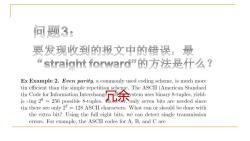
问题3: 要发现收到的报文中的错误。最 “straight forward的方法是什么? Ex Example 2.Even parity,a commonly used coding scheme,is much more tin efficient than the simple repetition scheme. The ASCII(American Standard 冗余 tin there are only 27=128 ASCII characters.What can or should be done with the extra bit?Using the full eight bits,we can detect single transmission errors.For example,the ASCII codes for A,B,and C are
冗余

阿题48 一个“貔码方案”究凳 是什么?
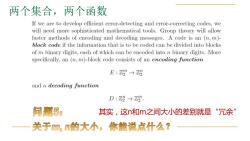
两个集合,两个函数 If we are to develop efficient error-detecting and error-correcting codes,we will need more sophisticated mathematical tools.Group theory will allow faster methods of encoding and decoding messages.A code is an (n,m)- block code if the information that is to be coded can be divided into blocks of m binary digits,each of which can be encoded into n binary digits.More specifically,an (n,m)-block code consists of an encoding function E:Z→Z and a decoding function D:z5→Z 问题58 其实,这n和m之间大小的差别就是“冗余” 关于m,m的大小,你能说点什么?
两个集合,两个函数 其实,这n和m之间大小的差别就是“冗余
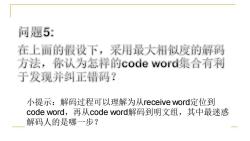
间题5: 在上面的假设下,采用最大相似度的解码 方法,你认为怎样的code word集合有利 于发现并纠正错码? 小提示:解码过程可以理解为从receive word定位到 code word,再从code word解码到明文组,其中最迷惑 解码人的是哪一步?
小提示:解码过程可以理解为从receive word定位到 code word,再从code word解码到明文组,其中最迷惑 解码人的是哪一步?
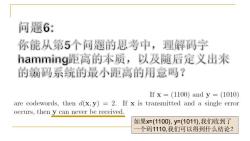
问题6: 你能从第5个间题的思考中,理解码字 hamming距离的本质,以及随后定义出来 的编码系统的最小距离的用意吗? Ifx=(1100)andy=(1010) are codewords,then d(x,y)=2.If x is transmitted and a single error occurs,then y can never be received. 如果=(1100),y=(1011),我们收到了 一个码1110,我们可以得到什么结论?
如果x=(1100), y=(1011),我们收到了 一个码1110,我们可以得到什么结论?
按次数下载不扣除下载券;
注册用户24小时内重复下载只扣除一次;
顺序:VIP每日次数-->可用次数-->下载券;
- 南京大学:《计算机问题求解》课程教学资源(PPT课件讲稿)数论基础.pptx
- 南京大学:《计算机问题求解》课程教学资源(PPT课件讲稿)群同态基本定理与正规子群.pptx
- 南京大学:《计算机问题求解》课程教学资源(PPT课件讲稿)群初步.pptx
- 南京大学:《计算机问题求解》课程教学资源(PPT课件讲稿)线性规划.pptx
- 南京大学:《计算机问题求解》课程教学资源(课件讲稿)矩阵计算.pdf
- 南京大学:《计算机问题求解》课程教学资源(课件讲稿)图论的其它专题(平面图与图着色).pdf
- 南京大学:《计算机问题求解》课程教学资源(课件讲稿)最大流算法.pdf
- 南京大学:《计算机问题求解》课程教学资源(课件讲稿)图中的匹配与覆盖(图中的匹配与因子分解).pdf
- 南京大学:《计算机问题求解》课程教学资源(课件讲稿)旅行问题(图旅行).pdf
- 南京大学:《计算机问题求解》课程教学资源(课件讲稿)图中的连通度和距离.pdf
- 南京大学:《计算机问题求解》课程教学资源(课件讲稿)多源最短通路算法 All-Pair Shortest Paths.pdf
- 南京大学:《计算机问题求解》课程教学资源(课件讲稿)单源最短通路算法.pdf
- 南京大学:《计算机问题求解》课程教学资源(课件讲稿)树.pdf
- 南京大学:《计算机问题求解》课程教学资源(课件讲稿)图的计算机表示以及遍历.pdf
- 南京大学:《计算机问题求解》课程教学资源(课件讲稿)图的基本概念.pdf
- 南京大学:《计算机问题求解》课程教学资源(课件讲稿)B树.pdf
- 南京大学:《计算机问题求解》课程教学资源(课件讲稿)用于动态等价关系的数据结构.pdf
- 南京大学:《计算机问题求解》课程教学资源(课件讲稿)贪心算法.pdf
- 南京大学:《计算机问题求解》课程教学资源(课件讲稿)动态规划.pdf
- 南京大学:《计算机问题求解》课程教学资源(课件讲稿)集合及其运算.pdf
- 南京大学:《计算机问题求解》课程教学资源(PPT课件讲稿)密码算法.pptx
- 南京大学:《计算机问题求解》课程教学资源(PPT课件讲稿)NP完全理论初步.pptx
- 南京大学:《计算机问题求解》课程教学资源(PPT课件讲稿)串匹配.ppt
- 南京大学:《计算机问题求解》课程教学资源(PPT课件讲稿)近似算法的基本概念.pptx
- 南京大学:《计算机问题求解》课程教学资源(PPT课件讲稿)算法问题的形式化描述.pptx
- 《计算机问题求解》课程参考书籍:《算法学——计算精髓》PDF电子版(Algorithmics - The Spirit of Computing,THIRD EDITION,David Harel).pdf
- 南京大学:《计算机问题求解》课程教学资源(PPT课件讲稿)为什么计算机能解题.ppt
- 南京大学:《计算机问题求解》课程教学资源(PPT课件讲稿)什么样的推理是正确的.pptx
- 南京大学:《计算机问题求解》课程教学资源(PPT课件讲稿)基本的算法结构.pptx
- 南京大学:《计算机问题求解》课程教学资源(PPT课件讲稿)常用的证明方法.pptx
- 南京大学:《计算机问题求解》课程教学资源(PPT课件讲稿)计算思维引导.pptx
- 南京大学:《计算机问题求解》课程教学资源(PPT课件讲稿)如何将算法告诉计算机.pptx
- 南京大学:《计算机问题求解》课程教学资源(PPT课件讲稿)数据与数据结构.pptx
- 《计算机问题求解》课程教学资源(阅读材料)Computational Thinking:What and Why?.pdf
- 南京大学:《计算机问题求解》课程教学资源(PPT课件讲稿)关系及其基本性质.pptx
- 南京大学:《计算机问题求解》课程教学资源(PPT课件讲稿)集合及其运算.pptx
- 南京大学:《计算机问题求解》课程教学资源(PPT课件讲稿)函数.pptx
- 南京大学:《计算机问题求解》课程教学资源(PPT课件讲稿)有限与无限.pptx
- 《计算机问题求解》课程教学资源(参考教材)Computer Algorithms - Introduction to Design and Analysis.pdf
- 南京大学:《计算机问题求解》课程教学资源(PPT课件讲稿)Hashing方法.pptx
